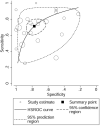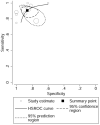A meta-analysis on the diagnostic performance of (18)F-FDG and (11)C-methionine PET for differentiating brain tumors
- PMID: 24029389
- PMCID: PMC7965151
- DOI: 10.3174/ajnr.A3718
A meta-analysis on the diagnostic performance of (18)F-FDG and (11)C-methionine PET for differentiating brain tumors
Abstract
(18)F-FDG-PET has been widely used in patients with brain tumors. However, the reported sensitivity and specificity of (18)F-FDG-PET for brain tumor differentiation varied greatly. We performed this meta-analysis to systematically assess the diagnostic performance of (18)F-FDG-PET in differentiating brain tumors. The diagnostic performance of (11)C-methionine PET was assessed for comparison. Relevant studies were searched in PubMed/MEDLINE, Scopus, and China National Knowledge Infrastructure (until February 2013). The methodologic quality of eligible studies was evaluated, and a meta-analysis was performed to obtain the combined diagnostic performance of (18)F-FDG and (11)C-methionine PET with a bivariate model. Thirty eligible studies, including 5 studies with both (18)F-FDG and (11)C-methionine PET data were enrolled. Pooled sensitivity, pooled specificity, and area under the receiver operating characteristic curve of (18)F-FDG-PET (n = 24) for differentiating brain tumors were 0.71 (95% CI, 0.63-0.78), 0.77 (95% CI, 0.67-0.85), and 0.80. Heterogeneity was found among (18)F-FDG studies. Subsequent subgroup analysis revealed that the disease status was a statistically significant source of the heterogeneity and that the sensitivity in the patients with recurrent brain tumor was markedly higher than those with suspected primary brain tumors. Pooled sensitivity, pooled specificity, and area under the receiver operating characteristic of (11)C-methionine PET (n = 11) were 0.91 (95% CI, 0.85-0.94), 0.86 (95% CI, 0.78-0.92), and 0.94. No significant statistical heterogeneity was found among (11)C-methionine studies. This meta-analysis suggested that (18)F-FDG-PET has limited diagnostic performance in brain tumor differentiation, though its performance may vary according to the status of brain tumor, whereas (11)C-methionine PET has excellent diagnostic accuracy in brain tumor differentiation.
© 2014 by American Journal of Neuroradiology.
Figures
References
-
- Chen W, Silverman DH, Delaloye S, et al. . 18F-FDOPA PET imaging of brain tumors: comparison study with 18F-FDG-PET and evaluation of diagnostic accuracy. J Nucl Med 2006;47:904–11 - PubMed
-
- Wong TZ, van der Westhuizen GJ, Coleman RE. Positron emission tomography imaging of brain tumors. Neuroimaging Clin N Am 2002;12:615–26 - PubMed
-
- Sasaki M, Kuwabara Y, Yoshida T, et al. . A comparative study of thallium-201 SPET, carbon-11 methionine PET and fluorine-18 fluorodeoxyglucose PET for the differentiation of astrocytic tumours. Eur J Nucl Med 1998;25:1261–69 - PubMed
-
- Zuo C, Liu Y, Guan Y, et al. . Clinical application of FDG-PET for the diagnosis of recurrent glioma. [in Chinese] Nuclear Techniques 2001;24:899–902
Publication types
MeSH terms
Substances
LinkOut - more resources
Full Text Sources
Other Literature Sources
Medical



